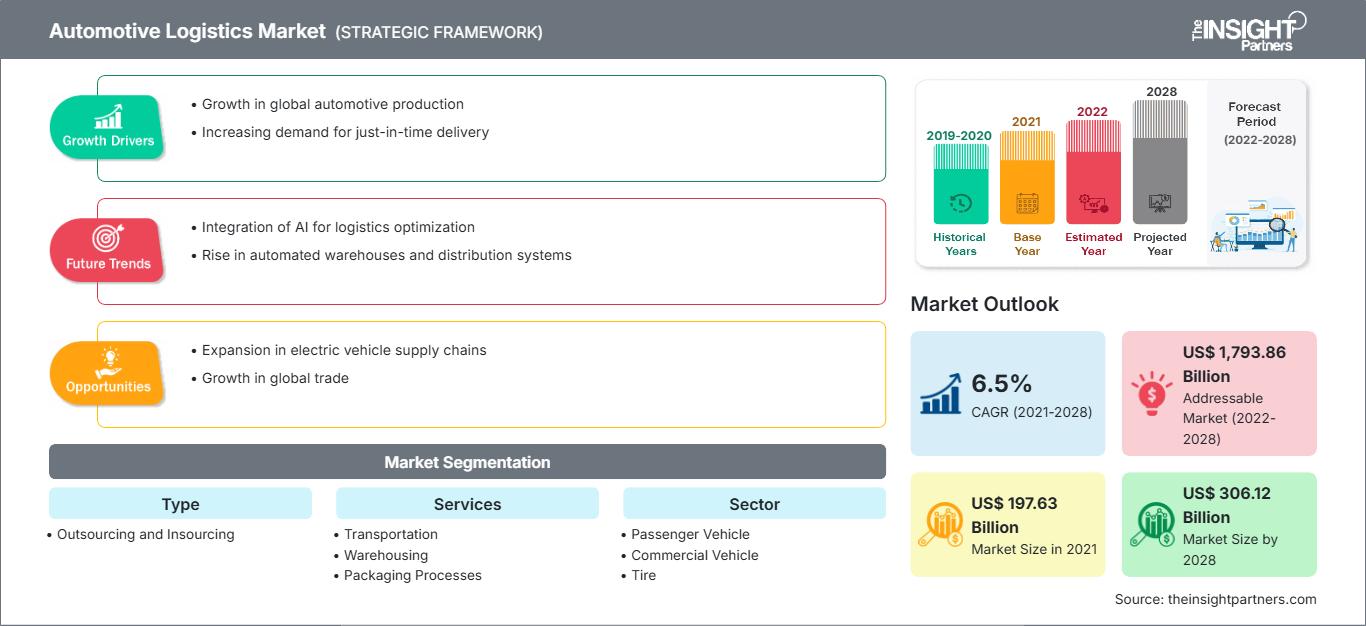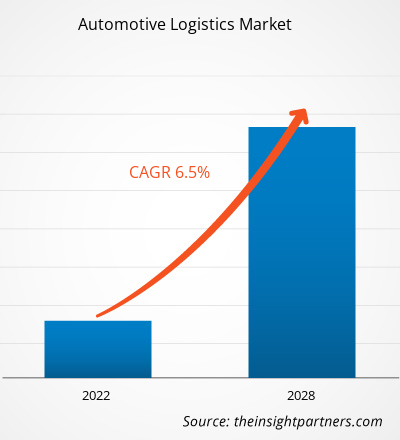[調査レポート]自動車物流市場は、2021年の1,97,630.46百万米ドルから2028年には3,06,121.54百万米ドルに成長すると予測されており、2021年から2028年にかけて6.5%のCAGRで成長すると予測されています。
アナリストの視点:
自動車物流市場は、業界全体における車両、自動車部品、スペアパーツの効率的な輸送において重要な役割を果たしています。自動車、車両、自動車物流を専門とする様々な企業が参入し、自動車製品の輸送、保管、配送などのサービスを提供しています。自動車物流企業は、自動車業界に関わる複雑なサプライチェーンの管理を担っています。製造工場から販売店、あるいは顧客への車両のシームレスな移動を確保しています。これらの企業は、輸送と物流に関する専門知識を活用し、ルートの最適化、配送時間の短縮、そして全体的な効率性の向上を実現しています。自動車物流会社は、自動車部品やスペアパーツの輸送と配送にも注力しています。これらの部品の調達、保管、そして組立工場や修理センターへの配送という複雑な業務を担っています。自動車部品物流会社は、専用のシステムとテクノロジーを活用することで在庫フローを効率化し、適切な部品が適切なタイミングで確実に供給されるようにしています。
物流は、自動車・輸送業界の円滑な運営を支える重要な要素です。自動車倉庫、在庫管理、梱包、リバースロジスティクスなど、様々な業務を網羅しています。効果的な自動車物流管理は、コスト削減、顧客満足度の向上、そして業務効率の向上につながります。自動車物流市場は、自動車物流関連の仕事を含む様々な雇用機会も提供しています。これらの仕事には、車両や自動車部品の輸送と配送の調整と監督が含まれます。物流業務の管理からサプライチェーンプロセスの最適化まで、この分野の専門家は、自動車製品のタイムリーかつ安全な輸送を確保する上で極めて重要な役割を果たしています。効率的なサプライチェーン管理とスペアパーツのタイムリーな配送に対する需要の高まりにより、世界の自動車スペアパーツ物流市場は大幅な成長を遂げています。物流コンサルタントは、自動車部品の物流プロセスを最適化し、コストを削減し、顧客満足度を向上させるための専門知識とソリューションを提供します。自動車部品物流は、サプライチェーン全体にわたるスペアパーツのシームレスな流れを確保します。一方、自動車部品物流は、市場の需要を満たすために自動車部品を効率的に輸送・流通することに重点を置いています。
市場概要:
完成車や自動車部品に関連する機械、在庫、資材などのリソースを、ある場所から目的の場所まで配置・輸送することを自動車物流と呼びます。顧客の需要を満たすために、これはある出発地点から消費地点までの商品の流れを管理することです。企業の完成品やサービスを生産する日々の業務を管理することが、物流管理の主な重点です。このような管理は、効率的かつ効果的に物品を前方、後方、そして保管庫へ移動させます。効率的でカスタマイズされた物流サービスに対する需要は、さまざまな物流サービスプロバイダー間の差別化要因となり、市場競争力を維持するために不可欠です。物流サービス企業は、ビッグデータ、モノのインターネット(IoT)、連結船舶などの破壊的技術を統合し、サプライチェーン管理システムの改善に取り組んでいます。
これらの技術は、人件費の削減と出荷遅延の解消に役立ちます。自動車産業への需要創出は、市場拡大に大きな影響を与えます。世界的な購買力の向上と生活水準の向上により、自動車部門は今後数年間で大きく発展すると予測されています。こうしたライフスタイルの変化に伴う新興国における自動車販売台数の増加は、予測期間中の市場成長を後押しすると予想されます。さらに、既存の道路上の大規模な自動車物流における自動車スペアパーツの需要増加も、予測期間中の市場成長を牽引すると予想されます。
要件に合わせてレポートをカスタマイズ
レポートの一部、国レベルの分析、Excelデータパックなどを含め、スタートアップ&大学向けに特別オファーや割引もご利用いただけます(無償)
自動車物流市場: 戦略的洞察

-
このレポートの主要な市場動向を入手してください。この無料サンプルには、市場動向から見積もりや予測に至るまでのデータ分析が含まれます。
市場の牽引役:世界的なEコマース業界の拡大が自動車物流市場の成長を牽引
自動車物流セクターの市場成長を牽引する重要な要因として、Eコマース業界の急速な拡大が浮上しています。消費者が車両、自動車部品、スペアパーツの購入にオンラインプラットフォームを利用するケースが増えているため、効率的な物流ソリューションの需要が急増しています。Eコマース活動の急増は、自動車、自動車、車物流企業に直接影響を与え、事業運営の変革と市場ポテンシャルの拡大をもたらしています。Eコマースは自動車販売の新たな手段となり、消費者はオンラインで車両を閲覧・購入できるようになりました。この傾向により、オンラインで購入された車両の輸送と配送を扱うための専門的な物流サービスの開発が必要となりました。自動車物流会社は、オンライン購入と実店舗での配送のギャップを埋め、車両が安全かつ効率的に購入者の元へ輸送されるよう支援しています。
さらに、eコマースの急成長は、オンラインマーケットプレイスを通じた自動車部品やスペアパーツの需要を促進しています。顧客は今や、自宅にいながらにして特定の部品やスペアパーツを注文できるという利便性を得ています。この変化に伴い、これらの商品の保管、梱包、配送管理を専門とする自動車部品物流サービスが登場しています。これらの物流会社は、専門知識を活用してサプライチェーンを合理化し、適切な部品が顧客に迅速に届けられるようにしています。eコマース業界の拡大は、自動車物流会社が業務強化のために革新的なテクノロジーと自動車物流ソリューションを導入するきっかけにもなっています。
高度な追跡システム、ルート最適化ソフトウェア、リアルタイム在庫管理ツールは、eコマース顧客の需要を満たす上で不可欠なものとなっています。これらのテクノロジーを活用することで、自動車物流会社は効率的で透明性の高いサービスを提供し、タイムリーな配送と高い顧客満足度を確保することができます。さらに、eコマース業界の成長は、自動車物流分野に新たな雇用機会をもたらしました。自動車物流、特にeコマースのフルフィルメント業務における仕事の重要性はますます高まっています。オンライン注文の管理、出荷の調整、物流業務の最適化に関する専門知識を持つ専門家の需要が高まっています。この傾向により、自動車物流市場における労働力の拡大が促進され、市場全体の成長に貢献しています。
セグメント分析:タイプに基づいて、自動車物流市場は次のように分類されます。
- アウトソーシング
- インソーシング
インソーシングセグメントは2020年に市場で最大のシェアを占めましたが、アウトソーシングセグメントは予測期間中に市場で最も高いCAGRを記録すると予想されています。自動車物流市場において、インソーシングセグメントが最大のシェアを占めています。これは、自動車会社やメーカーが物流業務を社内で管理することを選択しているためです。これにより、既存のリソースをより適切に管理、可視性、活用できるようになります。インソーシングにより、カスタマイズ、差別化、リアルタイムデータと分析へのアクセスが可能になります。アウトソーシングは依然として役割を果たしていますが、インソーシングの優位性が自動車物流市場全体の成長を牽引しています。
地域分析:
アジア太平洋地域の自動車物流市場は、2021年に867.7億米ドルと評価され、2028年までに1,423.4億米ドルに達すると予測されています。予測期間中、年平均成長率(CAGR)は7.3%と予想されています。アジア太平洋地域は、自動車物流市場で優位性を確立し、主要な地理的セグメントとして浮上しています。この地域の市場優位性には、堅調な自動車製造産業、急速な経済成長、拡大する消費者基盤など、いくつかの主要な要因が寄与しています。
まず、アジア太平洋地域には、世界最大級の自動車メーカーと生産拠点がいくつか存在します。中国、日本、韓国、インドなどの国々では、自動車セクターが著しく成長しており、世界中の自動車メーカーを誘致し、大規模な製造施設の設立を促進しています。この強力な自動車製造拠点は、自動車物流サービスへの大きな需要を生み出し、この地域の市場成長を牽引しています。第二に、アジア太平洋地域における急速な経済成長は、国内消費の急増と自動車需要の増加をもたらしました。この地域の国々では可処分所得の増加に伴い、自動車やその他の車両の購入が大幅に増加しています。こうした車両保有台数の増加は、車両や自動車部品の輸送、保管、配送を含む自動車物流サービスへの需要の高まりに直接つながります。
さらに、アジア太平洋地域の拡大する消費者基盤も、市場の優位性において重要な役割を果たしています。46億人を超える人口を抱えるこの地域は、自動車メーカーやサプライヤーにとって広大な顧客基盤を提供しています。中国やインドなどの国々では、中流階級の増加と都市化の進展により、巨大な自動車市場が形成されています。こうした自動車需要の増加は、タイムリーな配送を確保し、消費者の期待に応えるために、効率的で信頼性の高い自動車物流サービスを必要としています。さらに、アジア太平洋地域では、物流業務において先進技術とデジタル化が積極的に導入されています。電子商取引の台頭と、サプライチェーン管理システム、リアルタイム追跡、データ分析といったテクノロジー主導型ソリューションの統合により、アジア太平洋地域では自動車物流サービスの効率性と有効性が向上しています。
こうした技術革新は、アジア太平洋地域の市場優位性をさらに強化しています。政府のインフラ開発への取り組みと投資も、この地域の市場優位性に貢献しています。アジア太平洋地域諸国は、成長する自動車産業を支えるため、道路網、港湾、鉄道システムなどの輸送インフラに積極的に投資しています。これらのインフラ整備は、シームレスな輸送と効率的な物流業務を促進し、この地域を自動車製造・物流活動にとって魅力的な拠点にしています。
強力な業界プレゼンスと高度な物流インフラを備えた北米の自動車物流市場は、自動車物流市場において重要な役割を果たしています。北米では、自動車および自動車物流企業は、確立された自動車製造セクター、堅牢な輸送ネットワーク、そして技術革新への注力から恩恵を受けています。北米は主要な自動車メーカーの本拠地であり、米国、メキシコ、カナダに主要プレーヤーが進出する活況を呈する自動車市場を有しています。これらの企業は、自動車および自動車部品の輸送、保管、配送を含む自動車物流サービスに対する大きな需要を生み出しています。
著名な自動車メーカーやサプライヤーの存在が、この地域の自動車物流市場の成長を牽引しています。輸送インフラに関しては、北米は広範な道路網、鉄道網、そして接続の良好な港湾を誇っています。これらのインフラは、自動車および自動車部品の効率的な移動と配送を促進し、自動車物流企業が物流業務を最適化することを可能にします。この地域の輸送インフラは、タイムリーな配送を保証し、費用対効果の高い運用を可能にし、自動車物流市場全体の成長を支えています。さらに、北米は物流業界における技術革新を重視しており、デジタル化と自動化に重点を置いています。この地域の自動車物流企業は、サプライチェーン管理システム、リアルタイム追跡、データ分析などの最先端技術を活用することで、業務効率を高め、優れた顧客サービスを提供しています。これらの高度なソリューションを導入することで、北米の自動車物流企業は在庫管理の最適化、業務の合理化、そしてサプライチェーン全体の可視性の向上を実現しています。
さらに、北米では自動車業界におけるeコマースの重要性が高まっています。自動車販売や自動車部品流通のためのオンラインプラットフォームの台頭により、専門的な物流サービスに対する需要が高まっています。北米の自動車物流企業は、この傾向に対応して、eコマースプラットフォームを通じて購入された自動車や自動車部品の輸送・配送のためのカスタマイズされたソリューションを開発しています。eコマース物流への注力は、この地域の自動車物流市場の成長をさらに促進しています。政府の政策や取り組みも、北米の自動車物流市場に関する地域的な洞察に貢献しています。米国、メキシコ、カナダの各政府は、自動車産業を支援し、物流インフラを強化するための措置を実施しています。これには、輸送インフラへの投資、国境を越えた貿易協定の促進、自動車製造および物流業務に適した環境の醸成などが含まれます。
自動車物流市場の地域別分析
予測期間を通じて自動車物流市場に影響を与える地域的な動向と要因については、The Insight Partnersのアナリストが詳細に解説しています。このセクションでは、北米、ヨーロッパ、アジア太平洋、中東・アフリカ、中南米における自動車物流市場のセグメントと地域についても解説しています。
自動車物流市場レポートの範囲
| レポート属性 | 詳細 |
|---|---|
| の市場規模 2021 | US$ 197.63 Billion |
| 市場規模別 2028 | US$ 306.12 Billion |
| 世界的なCAGR (2021 - 2028) | 6.5% |
| 過去データ | 2019-2020 |
| 予測期間 | 2022-2028 |
| 対象セグメント |
By タイプ
|
| 対象地域と国 |
北米
|
| 市場リーダーと主要企業の概要 |
|
自動車物流市場におけるプレーヤー密度:ビジネスダイナミクスへの影響を理解する
自動車物流市場は、消費者の嗜好の変化、技術の進歩、製品メリットへの認知度の高まりといった要因によるエンドユーザーの需要増加に牽引され、急速に成長しています。需要の増加に伴い、企業は提供内容の拡充、消費者ニーズへの対応のための革新、そして新たなトレンドの活用を進めており、これが市場の成長をさらに加速させています。

- 入手 自動車物流市場 主要プレーヤーの概要
自動車物流市場の分析は、CEVA Logistics AG、DB Schenker、DSV A/S、DHL International GmbH(ドイツポストDHLグループ)、GEODIS、Kuehne + Nagel Management AG、日本通運株式会社、Ryder System, Inc.、XPO Logistics, Inc.、United Parcel Service of America, Inc.などのプレーヤーで構成されています。自動車物流のプレーヤーの中で、CEVA Logistics AGと日本通運株式会社は、多様な製品ポートフォリオを提供していることから、トップ2プレーヤーとなっています。
最近の動向:
自動車物流市場の企業では、合併や買収などの無機的および有機的な戦略が広く採用されています。以下に、最近の主要な市場動向をいくつか示します。
- 2023 年、ミシガン州はダイムラー トラック ノース アメリカおよび DTE エナジーと提携し、電気自動車 (EV) 貨物トラック用の新しい充電ハブを開発するために 1,300 万ドルの資金を確保しました。
- 過去2年間の分析、基準年、CAGRによる予測(7年間)
- PEST分析とSWOT分析
- 市場規模価値/数量 - 世界、地域、国
- 業界と競争環境
- Excel データセット
最新レポート
関連レポート
お客様の声
購入理由
- 情報に基づいた意思決定
- 市場動向の理解
- 競合分析
- 顧客インサイト
- 市場予測
- リスク軽減
- 戦略計画
- 投資の正当性
- 新興市場の特定
- マーケティング戦略の強化
- 業務効率の向上
- 規制動向への対応






















 無料サンプルを入手 - 自動車物流市場
無料サンプルを入手 - 自動車物流市場